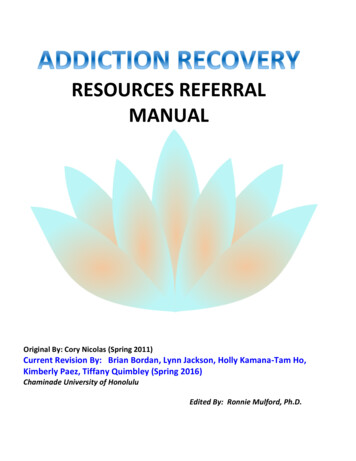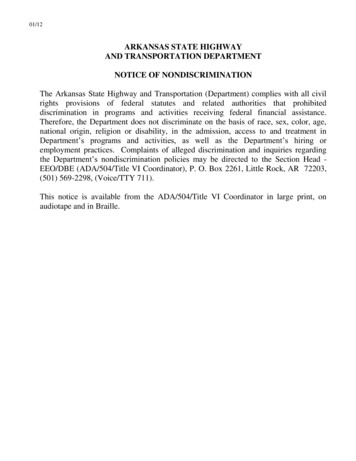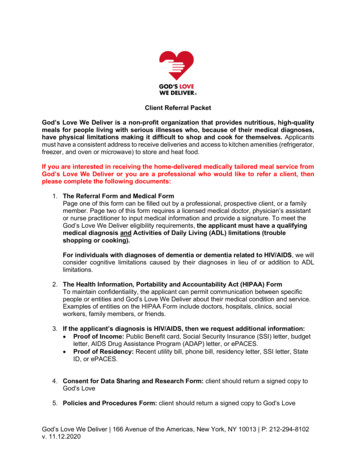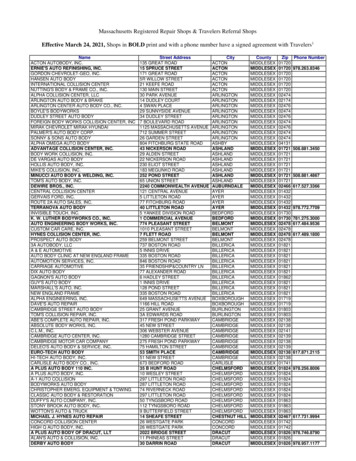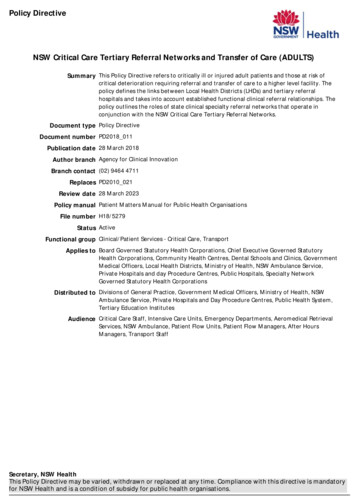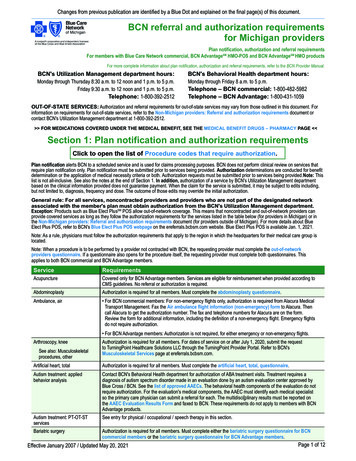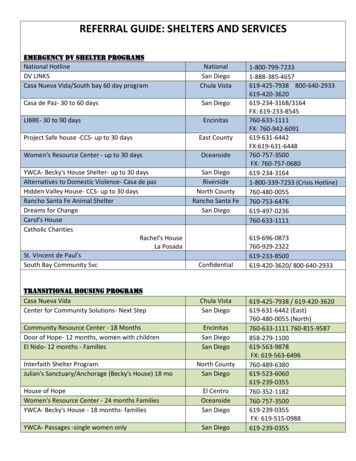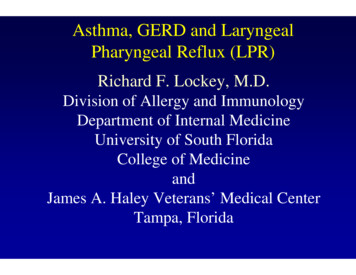
Transcription
TOOL FOR ASSESSING ASTHMA REFERRAL SYSTEMS1
TOOL FOR ASSESSING ASTHMA REFERRAL SYSTEMSTool forAssessingAsthma ReferralSystems2
TOOL FOR ASSESSING ASTHMA REFERRAL SYSTEMSThe Tool for Assessing Asthma Referral Systems (TAARS) was developed by evaluators in the Centers forDisease Control and Prevention (CDC) National Asthma Control Program. Its contents are solely theresponsibility of the authors and do not necessarily represent the official views of the CDC.Recommended citation: Tool for Assessing Asthma Referral Systems (TAARS). Atlanta, GA: Centers forDisease Control and Prevention, National Center for Environmental Health, Division of EnvironmentalHealth and Health Effects, Air Pollution and Respiratory Health Branch, October 2017.3
TOOL FOR ASSESSING ASTHMA REFERRAL SYSTEMSTool for Assessing Asthma Referral SystemsPrefaceThe Tool for Assessing Asthma Referral Systems (TAARS) is intended for use by asthma control programsas a guide in helping to understand the how effectively their referral systems are operating within theirprograms. Programs can use TAARS to conduct a comprehensive or more focused assessment of theirreferral system. Assessment may include determining how a referral system is structured, how networksare formed, whether appropriate written referral protocols and guidelines exist, the processes providersfollow to refer clients, how well referrals are tracked and followed up, and barriers to referral initiationand referral completion. Using TAARS can also help you better understand how the different types ofreferrals among the different service providers operate in communities.TAARS: Tool for Assessing Asthma Referral SystemsTAARS was adapted from the Referral Systems Assessment and Monitoring Toolkit, originally developedby MEASURE Evaluation for the President’s Emergency Plan for AIDS Relief (PEPFAR) for HIV/AIDS serviceproviders. This tool can be used as is or it can be adapted to the specific design and purpose of yourparticular asthma referral system. It may be most useful in the context of overall evaluation planning andimplementation, as recommended in the Learning and Growing through Evaluation series(https://www.cdc.gov/asthma/program eval/guide.htm.) Specifically, TAARS can help guide the focusand methodological considerations of a broader evaluation, such as is laid out in Steps 3 and 4 (Focus theEvaluation Design and Gather Credible Evidence) of the CDC’s Framework for Program Evaluation(https://www.cdc.gov/asthma/program eval/guide.htm).14
TOOL FOR ASSESSING ASTHMA REFERRAL SYSTEMSContentsPreface . 4Background . 6How to use TAARS . 61. Engage stakeholders . 72. Describe the referral system . 73. Include a visual depiction . 84. Identify evaluation questions . 95. Gather and review referral system protocols and other supporting documentation . 96. Conduct interviews . 137. Analyze the data . 15Acknowledgements . 18References and Resources. 195
TOOL FOR ASSESSING ASTHMA REFERRAL SYSTEMSBackgroundIntegrating health services across clinical and community-based settings improves the efficiency of thehealth system and provides greater access to services for clients, ultimately improving the well-being ofclients. Providing comprehensive asthma control services entails integration and linkages between clinicalservices and services that exist outside of the health system, such as social services, educational services,and community-based services. For this reason, referral systems, which may also be called linkagesystems, should be efficient, effectively connect people to needed services, and provide sufficient data toassure optimal care management.Community services sites often use their own unique, sometimes entirely unstructured, referral networks.These networks may rely solely on informal, personal recommendations. In these settings, there is notjust one referral system but several unstructured, very fluid systems operating simultaneously. A tool likeTAARS can help you better understand the nuances of those systems and help identify where the gaps areand where improvements can be made. TAARS can also be useful in developing contracts or agreementswith partners, describing the processes each uses for making or receiving referrals to or from programs,and to potentially encourage some level of standardization or consistency across programs. Further, andimportantly, documentation of the context for the referral system will promote understanding andcommunication across programs and serve as institutional memory, especially valuable when staffturnover occurs.1For additional guidance on evaluating referrals related to asthma home visiting programs. Please seeAppendix E of Evaluation of Services and Health Systems Interventions, Learning and Growing ThroughEvaluation Module 5. https://www.cdc.gov/asthma/program eval/asthmaprogramguide mod5.pdfHow to use TAARSAs you begin the evaluation planning process, you will need to scope your efforts to match the processesand timing, as well as the organization capacity of the entities engaged in the referral system. Forexample, the extent of the evaluation of referrals to and from community-based services is apt to differfrom that of referrals within a large health care network. Additionally, if your program is more establishedand includes case management that is responsible for ensuring linkages to resources, the scope and depthof your efforts may be more intensive. To this end, we recommend reviewing the entirety of TAARSbefore starting.6
TOOL FOR ASSESSING ASTHMA REFERRAL SYSTEMSTo use TAARS, follow the steps below, collecting the relevant information at the level of detail that fitsyour context and your needs. Tailor it to your program’s specifics.As with all evaluation processes, begin by engaging the stakeholders whohave an interest in the referral system. These may include service providers,case managers, clients, and those involved in recording and trackingreferrals. In addition to improving your evaluation, stakeholder participationin the assessment will raise awareness about the importance of referrals,motivate reflection, and generate interest in strengthening the referral system.1. Engage stakeholdersEngage stakeholders in determining the purpose for evaluatingthe referral system. The assessment can serve to: Identify what processes are used to documentreferrals Identify what works well and what needsimprovement Establish a formalized referral network of service providers Assess written protocols and identify any need for modifications Strengthen the mechanisms for making and tracking referrals and examine efficiency Determine how well services are integrated Determine whether all patient populations are equitably served through the referral system2. Describe the referral systemDescribe the referral system by: Defining the coverage and scope of the referral system. (Does it cross health sectors? Does itcover sectors beyond health, such as education, housing, social services, etc.?) Making a list of the range of services offered; document services that are needed but not offeredor available. Describing the expected referral pathways, describing which services should refer to which otherservices and documenting areas of expected bi-directionality.7
TOOL FOR ASSESSING ASTHMA REFERRAL SYSTEMS3. Include a visual depictionIn addition to a narrative description, a flow chart or other graphic of how the referral system isstructured may be helpful by detailing the universe of services and direction or bi-directionality of thereferrals. Once you have a visual depiction or graphic, engage stakeholders to ensure there is sharedunderstanding of the referral system and how it is intended to work.Figure 1: The above diagram depicts the theoretical concept behind Rhode Island’s ComprehensiveIntegrated Asthma Control System and the intended linkages. This graphic illustrates the intricate bidirectional connections among programs and defines the range of the network linking asthma patientsand their families to services. Providers within each of RI’s core asthma programs (HARP, BEAH, CASE,DAB) refer asthma patients to programs based on pre-determined eligibility and, in turn, receiveinformation back from these programs, which encompass home, school, clinical, and communityenvironments. Evaluation of the referral system tests the flow of information illustrated by the arrows.8
TOOL FOR ASSESSING ASTHMA REFERRAL SYSTEMS4. Identify evaluation questionsOnce you have a shared understanding of the referral system, engage in discussion to identify theevaluation questions that will effectively address the evaluation purpose. For example, you may want toknow whether the protocols for the referral system are adequate and contain sufficient information, or ifthe referral system captures referrals in a timely manner such that it facilitates appropriate interventions.Be aware that reviewing the referral system protocols might elicit additional important evaluationquestions you will want to answer.Consider what your stakeholders need to know and how theinformation will be used. Tailor the design of your datacollection efforts accordingly, bearing in mind the issue of“credibility” (i.e., evidence your stakeholders will value as validand reliable.) Align efforts to your specific needs.5. Gather and review referral system protocols and other supporting documentationDetermine if protocols or other guidance documents exist for referral system operations andexpectations. Carefully review the protocols and all supportingdocumentation for pertinent information, noting any critical missingpieces. See Table 1 for a sample review template.Table 1: Sample Template: Document review for referral systemassessmentSystem AspectDocumentsCharacteristicsReferral protocolsof referralReferral guidelinesIssues to consider Do referral protocols exist? (If not, whatis the feasibility of developing a protocol?network andOf establishing a bi-directional referralsystemsystem? What are the constraints?) Are protocols widely available to serviceproviders within the network (i.e., at each9
TOOL FOR ASSESSING ASTHMA REFERRAL SYSTEMSSystem AspectDocumentsIssues to considerfacility or organization)? -Are protocolsclinically sufficient? Do protocols cover the full range ofrelevant services? Do protocols reveal gaps in availableresources and, if so, are measures beingtaken to fill those gaps? Do protocols include documenting howreferrals are used (e.g., linkages toservices; decision support; etc.) and typeof settings they occur in (hospital, FQHC,pharmacy, etc.) Do protocols clearly describe how totrack and document referrals? Do protocols capture the bi-directionalityof referrals? Do protocols capture the method ofreferral delivery (e.g., in-person one-onone, in-person group, electronic, phone,etc.)? Do protocols describe how to ensureclient confidentiality? Are client preferences and logistic needsincluded in the referral protocol? Is everyone in the network using thesame protocol?Directory of Network Services(listing of organizationsproviding related services inthe geographic unit) Do directories exist in relevantgeographic areas or districts? Do directories include current contactinformation, location, hours of operation,and other relevant information? Are directories regularly updated?10
TOOL FOR ASSESSING ASTHMA REFERRAL SYSTEMSSystem AspectDocumentsIssues to consider Are needed programs and servicesavailable in the relevant geographic unit(districts)?Formal agreement between Are providers in the network formallyreferring and receivinglinked (i.e., formal agreements existinstitutions (for eachacross services)?organization and referringpathway) Do agreements cover the full range ofrelevant services? Do agreements specify processes forinitiating referrals? Do agreements contain informationregarding documentation of referrals? Do agreements specify total duration ofreferred program or service? (e.g., 6month program, one time appointment,etc.)Systems forExamples of registers, referral Are the necessary data elements beingtracking bi-forms or tools useddirectionality ofcollected by all facilities andorganizations involved?referrals Is bi-directionality of referrals capturedand tracked? Is there consistency across providers onthe type of information collected and theway it is collected? Is client confidentiality maintained?Report with compiled or Are data being collected and analyzed?analyzed referral data Are recommendations for improvementproposed? Is referral-related information written anddisseminated to stakeholders? Are reports and findings available atfacilitie
Figure 1: The above diagram depicts the theoretical concept behind Rhode Island’s omprehensive Integrated Asthma Control System and the intended linkages. This graphic illustrates the intricate bi- directional connections among programs and defines the range of the network linking asthma patients and their families to services. Providers within each of RI’s core asthma programs (HARP, EAH .

